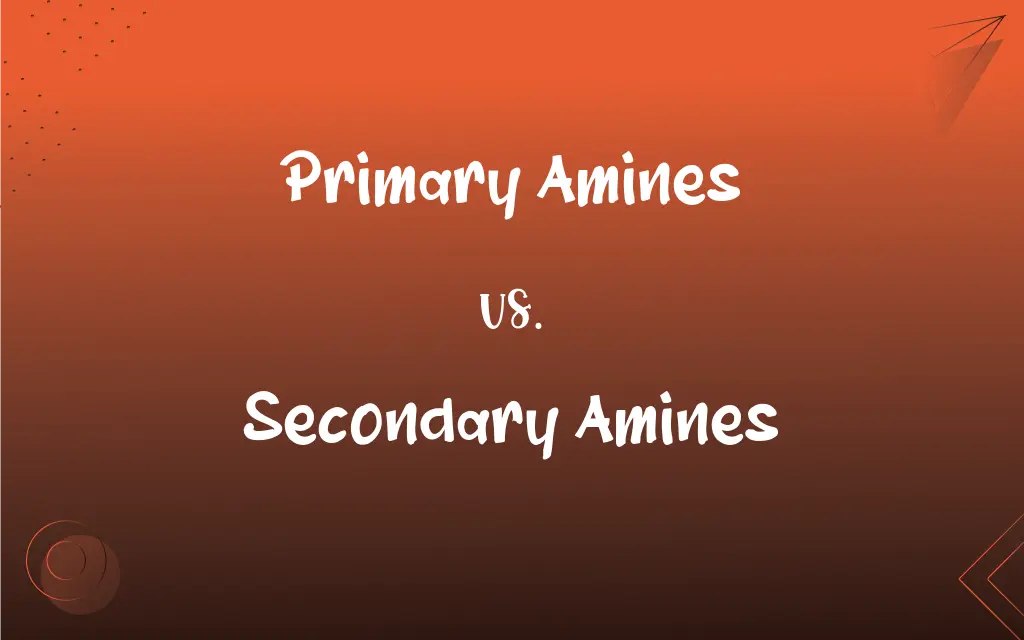Primary Amines vs. Secondary Amines: What's the Difference?
Edited by Aimie Carlson || By Harlon Moss || Updated on October 21, 2023
Primary amines have one carbon attached to the nitrogen, while secondary amines have two carbons attached to the nitrogen.

Key Differences
Primary amines are organic compounds where the nitrogen atom is bonded to one alkyl or aryl group. In contrast, secondary amines are those where the nitrogen atom is connected to two alkyl or aryl groups.
In terms of structure, primary amines can be represented by the formula R-NH2, where R is an alkyl or aryl group. On the other hand, secondary amines have the general formula R1R2NH, where both R1 and R2 can be the same or different alkyl or aryl groups.
Primary amines tend to have higher boiling points compared to secondary amines of similar molecular weights. This is attributed to the stronger hydrogen bonding in primary amines due to the presence of two hydrogen atoms bound to the nitrogen.
Reactivity also distinguishes these compounds. Primary amines can be easily acylated due to the presence of two replaceable hydrogen atoms. Conversely, secondary amines, having only one replaceable hydrogen on the nitrogen, can be acylated once.
In terms of odor, many primary amines are associated with a fishy smell. Secondary amines, however, often have more complex odors, ranging from pleasant to putrid, depending on their structure and substituents.
ADVERTISEMENT
Comparison Chart
General Formula
R-NH2
R1R2NH
Number of R groups
One alkyl/aryl group attached to nitrogen
Two alkyl/aryl groups attached to nitrogen
Hydrogen Bonding
Stronger due to two hydrogens on nitrogen
Weaker compared to primary amines
Acylation Potential
Can be acylated twice
Can be acylated once
Typical Odor
Often fishy
Ranges from pleasant to putrid
ADVERTISEMENT
Primary Amines and Secondary Amines Definitions
Primary Amines
Amines with the formula R-NH2.
Ethylamine, CH3CH2NH2, represents primary amines.
Secondary Amines
Amines that undergo acylation once.
Acetic acid can react once with secondary amines like dipropylamine.
Primary Amines
Nitrogen compounds that can form two hydrogen bonds.
Primary amines like propylamine have two hydrogens on the nitrogen for bonding.
Secondary Amines
Nitrogen compounds represented by R1R2NH.
Diethylamine, (CH3CH2)2NH, showcases secondary amines.
Primary Amines
Derivatives of ammonia where one hydrogen is replaced by an alkyl/aryl group.
Aniline is one of the aromatic primary amines.
Secondary Amines
Organic compounds with two alkyl/aryl groups bonded to a nitrogen.
Dimethylamine is a simple example of secondary amines.
Primary Amines
Amines that can undergo acylation twice.
Acetic acid can react with primary amines like butylamine twice.
Secondary Amines
Amines that form one hydrogen bond due to a single hydrogen on nitrogen.
Secondary amines like dibutylamine have just one hydrogen available for bonding.
Primary Amines
Organic compounds with one alkyl/aryl group bonded to a nitrogen.
Methylamine is an example of primary amines.
Secondary Amines
Amines where two hydrogens of ammonia are replaced by alkyl/aryl groups.
Diphenylamine is among the aromatic secondary amines.
FAQs
Can primary amines form hydrogen bonds?
Yes, primary amines can form two hydrogen bonds due to two hydrogens on nitrogen.
What characterizes secondary amines?
Secondary amines have two alkyl or aryl groups attached to the nitrogen atom.
How many hydrogen bonds can secondary amines form?
Secondary amines can form one hydrogen bond because of a single hydrogen on nitrogen.
What's the general formula for primary amines?
The general formula for primary amines is R-NH2.
Are primary amines more basic than secondary amines?
Generally, primary amines are slightly more basic than secondary amines.
Which has a stronger fishy smell, primary or secondary amines?
Primary amines typically have a more pronounced fishy odor.
What about the acylation of secondary amines?
Secondary amines can be acylated once.
Are primary amines derivatives of ammonia?
Yes, primary amines are derivatives where one hydrogen of ammonia is replaced by an alkyl or aryl group.
Can primary amines be synthesized from alcohols?
Yes, primary amines can be synthesized from alcohols using specific reagents.
Are there tests to distinguish primary from secondary amines?
Yes, reactions with specific reagents can distinguish between them.
Can secondary amines form amides?
Secondary amines can react with acids, but they produce N-substituted amides.
What are primary amines?
Primary amines are compounds where nitrogen is bonded to one alkyl or aryl group.
How many times can primary amines be acylated?
Primary amines can be acylated twice.
How are secondary amines produced industrially?
Secondary amines can be produced by reacting primary amines with alkyl halides, among other methods.
Are primary amines typically liquid or solid?
Lower molecular weight primary amines are usually gases or liquids, while higher ones can be solids.
How are secondary amines derived from ammonia?
Secondary amines replace two hydrogens of ammonia with alkyl or aryl groups.
How are secondary amines represented formula-wise?
Secondary amines have the general formula R1R2NH.
Is it easier to prepare primary or secondary amines?
Both have specific methods of preparation, but primary amines can be directly derived from ammonia.
What about the physical state of secondary amines?
Lower molecular weight secondary amines are typically liquids, and higher ones can be solids.
Do primary amines participate in the formation of amides?
Yes, primary amines can react with acids to form amides.
About Author
Written by
Harlon MossHarlon is a seasoned quality moderator and accomplished content writer for Difference Wiki. An alumnus of the prestigious University of California, he earned his degree in Computer Science. Leveraging his academic background, Harlon brings a meticulous and informed perspective to his work, ensuring content accuracy and excellence.
Edited by
Aimie CarlsonAimie Carlson, holding a master's degree in English literature, is a fervent English language enthusiast. She lends her writing talents to Difference Wiki, a prominent website that specializes in comparisons, offering readers insightful analyses that both captivate and inform.































































